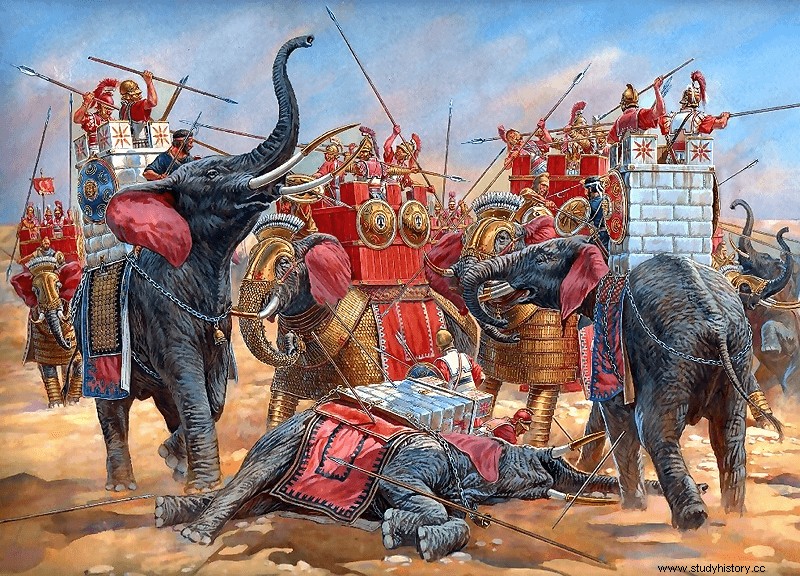"Animal Duel" (Animal Face-Off ) is a television program in which virtual confrontations between two different species are recreated to discover who would win in real life. Using data from scientists and experts, they are recreated in mechanical models, based on the strength, size, weight, types of attacks, qualities and weaknesses of the two animals in the laboratory, in the end these results are brought to a virtual duel together with the type of environment where the fight would originate, it is decided who wins and at the end of each encounter it is explained why the animal was the winner. Well, if at any time there has been a confrontation between African and Asian elephants, there is no need to recreate it... it happened in 217 BC. in the battle of Rafia who faced Antiochus III the Great and Ptolemy IV Philopator .

When Antiochus III the Great acceded to the throne of the Seleucid Empire in 223 BC. his empire was beginning to crack. The largest Hellenistic kingdom since the division of the diacods had suffered a serious setback in its borders, losing the eastern end (Bactria) to the Parthians, as well as territories in Galatia and Pamphylia (where his brother met his death in a vain attempt to recover them) and the constant pressure from the south by the Ptolemies of Egypt, very troublesome neighbors who were a constant focus of hostilities throughout his reign. In this precarious situation began the reign of him Antiochus III. His first target was precisely the neighbor of the Nile, causing the Fourth Syrian War in 219 BC. After occupying Judea and Palestine for two years, the Seleucid king planted himself in Egypt with 62,000 infantry, 6,000 horsemen and 102 Asian war elephants. Ptolemy IV Filpotor had similar numbers to those of his adversary, 60,000 infantry, 5,000 horsemen and 73 African war elephants. This numerical disadvantage did not condition the outcome of the Battle of Rafia (Gaza) on June 22, 217 BC. and Ptolemy put the Seleucid army to flight inflicting over 10,000 casualties. Antiochus III was forced to sign a forced peace in which Ptolemy IV took a cut, recovering all of Palestine for his kingdom.
Ignoring the final result of the battle, we will focus on the direct confrontation between both species, and for this we will turn to the Greek historian Polybius in the work Histories…
But he admired even more to see the same elephants fighting and wounding themselves head-on; because the fighting of these animals is like this:they get entangled, they attack with all their might so as not to lose ground, until the most powerful moves aside the trunk of their antagonist. Once it is crooked, he grabs him by the flank and charges him, the way bulls do with antlers. Most of Ptolemy's elephants feared combat. This is very common in African elephants. In my opinion, it consists in the fact that they cannot bear the smell and the roar of the Indians, and frightened by their magnitude and strength, they flee before they approach, as indeed happened then. Because the beasts were in an uproar, they disordered the lines in front of them, and oppressing Ptolemy's royal guard made them turn their backs

If we look at its physical appearance and its character (the African is larger, heavier and more aggressive), one might think that, in a direct confrontation with a similar number of specimens for each species -as occurred in the description of Polibius on the left wing of the battle-, the Africans would defeat the Asians. Why wasn't it? Because African elephants, unlike their Asian relatives, are not easily domesticated. That is precisely why Asians are the usual ones in zoos, circuses and even in Tarzan movies, where he is mounted on an Asian elephant with false ears so that it is not so noticeable.
Regardless of the belief that elephants are terrified of mice, there are several examples in history in which they have been defeated taking advantage of their fearfulness, such as in the Battle of Zama, where Scipio pulled bugles and drums to scare mice. Hannibal's elephants and causing chaos; in the siege of the Macedonian troops of Antigonus II Gonatas to Megara, where to get rid of the siege of the pachyderms the inhabitants of Megara released a herd of pigs, on which they had previously poured oil and set fire, and before that mass of fire that emitted thunderous shrieks they stampeded away killing many Macedonians or when Tamerlane, in his conquest of the Delhi sultanate, had to face 120 armored elephants with their tusks impregnated with poison and ordered to load their camels with straw and wood and after setting fire to the load launch them against the elephants that, logically, fled. In the midst of the chaos, the noise and the blows received, typical of a battle, it is normal for the worst trained or domesticated elephants - the Africans - to follow their natural institutes and flee. The Asians were more "controllable" in the circumstances that occurred in Rafia.
However, this solution directly raises another question:how did Hannibal manage to get his African elephants from Carthage to Rome? Among the different explanations to this question, I think the most solid is the one that explains that Hannibal derived from a subspecies that would exist in the Atlas Mountains, disappeared when this region had less rainfall and became more arid -remember that a The adult African male eats about 200 kilos of vegetables and fruits a day, which were smaller than the sub-Saharan species and, above all, much more docile. In fact, the last elephant to fall in Hannibal's odyssey to conquer Rome was his, which was called Surus (Syrian), and his name seems to indicate that he was Asian.
Sources:Hannibal's Elephants, The battle between Asian and African elephants
